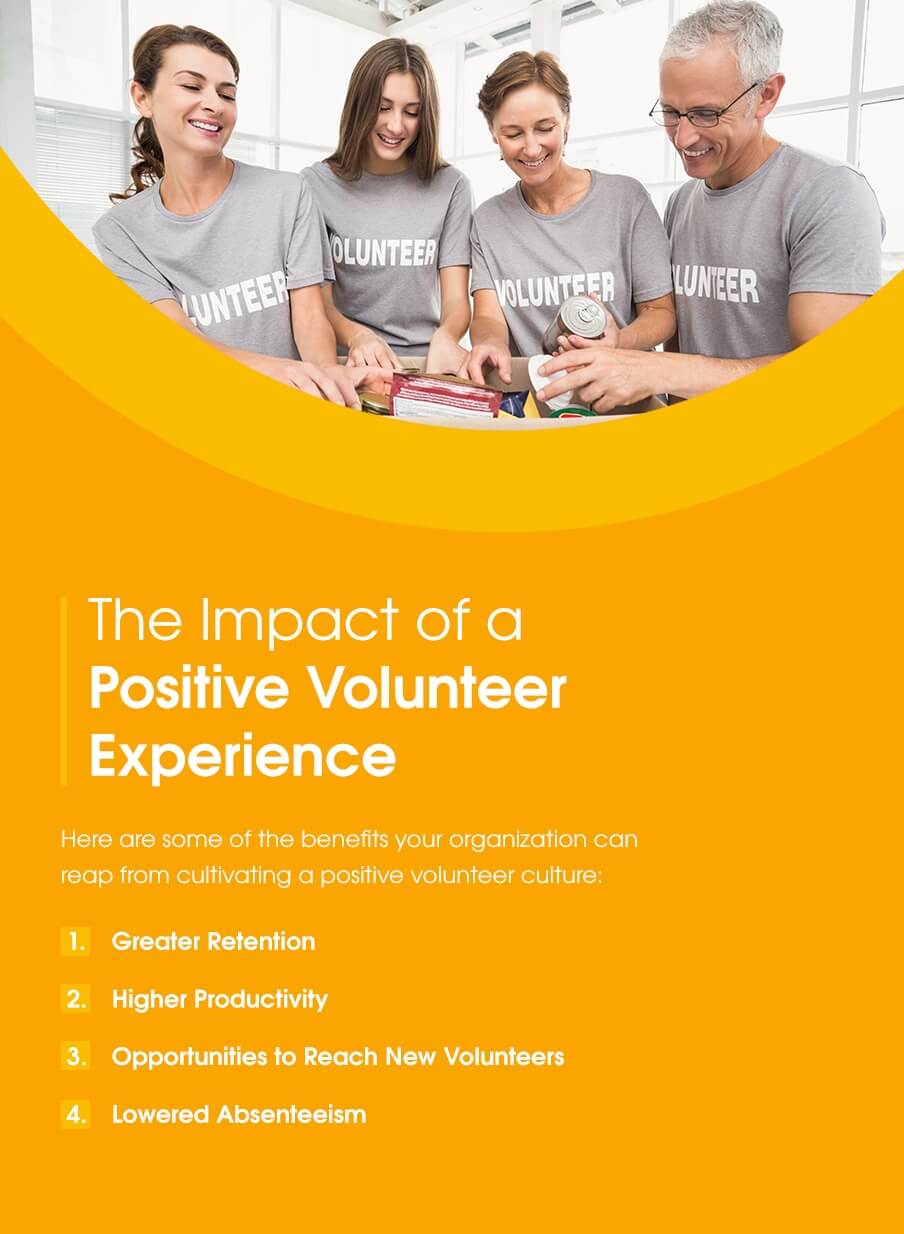Volunteers in the United States are a powerful, constructive force. In 2018, 77.4 million Americans volunteered their time and efforts, working for a cumulative 6.9 billion hours and producing an estimated $167 billion worth of labor. They generate tremendous value for the organizations they serve — both economically and intangibly with warmth, goodwill, passion, and determination.
Given that volunteers do so much to improve their organizations, it’s natural for organizations to wonder how to improve the volunteer experience. In the guide below, we’ll offer some tips on how to improve the volunteer experience, how to engage volunteers, and how to increase volunteer retention and productivity by making their work more meaningful.
Why the Volunteer Experience Impacts Your Organization
Improving the volunteer experience benefits the volunteers and your organization. Before we get into our list of tips to improve your volunteer program, let’s discuss a few reasons why enhancing volunteers’ experience is so essential.
1. Building Your Organization’s Reputation
When you’re thinking about how to improve your volunteer program, your organization’s reputation may not be the first thing on your mind. But providing a positive experience for your volunteers helps boost your organization’s standing in the community. A quality experience makes your volunteers happy, and happy volunteers are more likely to promote their work and your mission among their friends.
If other people know you care enough about your volunteers to craft an enjoyable, rewarding experience for them, your organization is likely to enjoy increased community standing. And a polished reputation may lead to increased community support.
2. Boosting Volunteer Engagement
A quality volunteer experience helps make volunteers feel more invested in their work with you. If volunteers enjoy their work and feel a sense of purpose, they are more likely to experience genuine engagement with your programs, mission, and goals. Strong volunteer engagement can lead to a host of other benefits, from heightened volunteer retention to increased productivity and support.
3. Increasing Support for Your Staff and Mission
A quality volunteer experience helps increase the support your organization receives. When staff members have volunteers they see regularly, engage with personally, and trust to get things done, they can delegate tasks and focus on their most pressing issues. Volunteers who enjoy their experience at your organization are more likely to be cooperative and proactive in finding out what your staff members need done and how best to support them.
4. Expanding Organizational Capacity

Enhancing your volunteer experience can increase the amount of good your organization does. When volunteers are happy and engaged, they bring more personal resources to your organization. Their enthusiasm, dedication, and perseverance can help you reach further into your community with more programs and services.
10 Ways to Grow Your Organization By Improving the Volunteer Experience
Below are some tips for creating good volunteer experiences in your organization:
1. Give Your Volunteer’s Sufficient Training
Proper training is essential to the development of a positive volunteer experience. Volunteers left to fend for themselves without adequate direction and guidance may feel frustrated and unnecessary.
Proper training helps give volunteers knowledge and a sense of purpose. It gives them an understanding of how the organization runs and the tools they need to make a difference. An initial volunteer orientation meeting, further specialized sessions, and a comprehensive volunteer handbook can serve as useful training tools.
2. Keep Your Volunteers Organized With Volunteer Management
One of the best ways to improve your volunteer program is to be methodical and organized. When an organization exists in a state of controlled chaos, it can take longer for volunteers to find a secure footing. They may not understand what you expect of them or what they should do when.
Being organized in your volunteer program may include developing routines for the following practices:
- Logging in
- Tracking hours
- Picking up nametags
- Checking with the volunteer manager or a task board for tasks
These procedures can help volunteers feel more grounded and secure while they serve.
3. Make the First Day a Good One
When you’re thinking about how to get volunteers to show up, you can begin as early as their first day. First impressions are critical for determining the quality of relationships, and many new volunteers are still deciding whether they want to make a long-term commitment. Be sure to make a good impression on your new volunteers as soon as they walk through the door.
Even if your offices are busy, take the time to introduce yourself and thank your new volunteers for their commitment. Show them around the office and introduce them to key staff members. Have specific tasks lined up so they can feel productive right away. Let them know what you’d like them to do, make sure they have the resources they need to do it, and make yourself available to answer questions. If volunteers feel supported and enjoy their first day it can lay the foundation of an enduring relationship.
4. Connect Tasks to the Cause and Provide Meaning
Taking time to create meaningful volunteer experiences is an excellent way to improve your volunteer program. If volunteers get stuck licking envelopes or filing documents for hours, they’ll probably feel disconnected from your organization’s true purpose and goals. The Harvard Business Review has found that workers who find their jobs meaningful are 69% less likely to quit within the next several months. Similar numbers are likely to hold for volunteers.
Be sure to give your volunteers tasks that go to the heart of your mission. At an animal shelter, let volunteers provide pets with hands-on enrichment by walking them, playing with them, or reading to them. At an organization working to alleviate food insecurity, let volunteers get involved with preparing and serving food. These experiences help volunteers feel that they are making a meaningful difference and can inspire them to deepen their connection with your work.
5. Recognize Outstanding Efforts

When you’re planning how to improve volunteer satisfaction, be sure to reward effort and achievement. Thanking your volunteers frequently for their work is a great practice. Be sure to recognize their efforts when they go above and beyond for you as well. Consider creating an annual or monthly volunteer award and showcasing volunteers’ best achievements — whether those achievements involve raising funds, accomplishing challenging tasks, or reaching a milestone in the length of their service.
6. Communicate Effectively Within Your Organization
Effective communication is key to a positive working relationship with your volunteers. If you have particular policies in place for safety reasons, let volunteers know upfront. If you need your volunteers to check in every day before they start their tasks, let them know that too. Giving them clear insight into your reasoning is often persuasive. If you merely tell volunteers to wear their nametags, they may forget. But if you highlight the security concerns of having unidentified personnel in the building, they may be more likely to comply.
You can use nonverbal communication effectively as well. Use a whiteboard to list tasks volunteers can sign up for, allowing them to choose a favored activity. Or write thank you cards or informative emails to keep volunteers engaged and informed.
7. Ask For Feedback From Volunteers
A large part of improving the volunteer experience is asking volunteers about their opinions and wishes. In addition to letting your volunteers know what you need from them, ask them what they need from you. You can ask for feedback directly, telling volunteers you’d like to get a sense of what is working for them and what isn’t.
You can also give them a satisfaction survey to fill out, either on paper or electronically. Some volunteers will be more inclined to provide honest feedback if they are able to think through their ideas in private and keep their responses anonymous. Asking volunteers for feedback tells them you value their input and care about giving them positive experiences.
8. Provide Mentorship
When you’re thinking about how to increase volunteer support, consider the role of mentorship. Volunteers who feel invested in your organization’s work may want to improve their skills and knowledge, but they may not be sure how to do so. A CNBC partner survey suggests that a tremendous 91% of workers who have mentors are happy with their jobs — so why not extend that same opportunity for satisfaction and meaning to your volunteers?
Reward your volunteers’ hard work and curiosity by mentoring them in their interests. At an animal shelter, if your volunteers are interested in behavior, consider providing training that allows them to work effectively with fearful dogs. If you’re a conservation organization, teach volunteers long-term strategies for planting trees or fostering biodiversity in your ecosystem.
9. Offer Social Experiences
Part of creating a rewarding volunteer experience often involves creating opportunities for social engagement. Social experiences with your organization can take many forms. They might be as simple as scheduling several volunteers for the same shift time so they can chat and get to know one another as they work. Or, if you’re holding a fundraiser like a walkathon or gala event, consider letting your volunteers attend to socialize and view another side of your mission. You can also consider fun treats like ice cream socials or thank you parties to show your appreciation and give your volunteers some energizing social time.
10. Be Professional
One of the best tips to improve volunteer support is to be professional. Even though volunteers are unpaid members of your organization, they still deserve the same professionalism and respect your employees do. Be courteous to your volunteers, and be understanding if they arrive a few minutes late, make mistakes, or accomplish only a few tasks during their shifts. Maintain consistent schedules, follow through on your promises, and treat all your volunteers fairly. Basic professionalism makes your volunteers feel respected and valued, and it is likely to keep them coming back to contribute their time and talents again and again.
The Impact of a Positive Volunteer Experience

Now that we’ve discussed some ways to improve the volunteer experience, let’s explore the impact a positive volunteer experience can have on your organization. Here are some of the benefits your organization can reap from cultivating a positive volunteer culture:
1. Greater Retention
One out of every three volunteers who gives their time one year does not come back the next. When you’re thinking about ways to improve volunteer retention, enhancing volunteers’ experiences can make a noticeable impact on this number.
When volunteers find their work rewarding and enjoy a positive atmosphere while doing it, they have a much greater incentive to stay. And increasing volunteer retention offers many additional benefits, including a consistent volunteer culture, fewer resources spent on recruiting and training, and the diversified skill sets and evolving accomplishments that come from having volunteers who have long-term familiarity with your work.
2. Higher Productivity
Taking steps to improve the volunteer experience will allow your organization to see higher productivity from volunteers and employees. Volunteers who enjoy their experience with your organization will feel more engaged when they come in, and their sincere engagement is likely to lead to higher productivity.
Boosted productivity is also a natural consequence of greater retention. When volunteers have a positive experience, they tend to come back, and volunteers who stay with your organization know its processes well enough to understand what needs to be done and do it correctly.
Having capable, engaged volunteers can make your staff more productive because volunteers can shoulder certain tasks easily, allowing staff members to focus on their core work.
3. Opportunities to Reach New Volunteers
One of the great benefits of making sure your volunteers have a positive experience is that they quickly spread the message to others. If they enjoy and feel proud of their work, they are more likely to invite friends and family members to join them. And if you’re actively focusing on improving your organization’s volunteer experience, you likely maintain a strong rapport with your volunteers. If you want their help with recruiting efforts, you have a solid, trusting relationship through which to reach out.
4. Lowered Absenteeism
Improving volunteer experience also helps ensure that volunteers will show up for their shifts, even if it isn’t always convenient. Disengaged workers have a 37% higher rate of absenteeism than engaged workers, and similar numbers hold true for volunteers.
Volunteers who don’t feel engaged with their work may find that their life commitments keep them from coming in. They may have a headache, or a soccer game, or the weather isn’t looking great this weekend — and then the next week finds them succumbing to similar distractions. But volunteers who have a positive experience are more likely to prioritize their shifts and show up.
Create a Positive Volunteer Experience with Volgistics
Now that you’ve read some tips to improve the volunteer experience, you can start putting some of these points into action. To see the benefits of strengthening your volunteer program by streamlining volunteer operations, partner with Volgistics.
Volunteers need to feel in control of their experience, and volunteer management software can help. It provides intuitive, user-friendly ways for volunteers to create profiles, choose a schedule, track hours, receive feedback, cancel shifts when they need to, and view supportive messages like thank you notes and birthday or holiday wishes. Volgistics makes overseeing volunteers enjoyable and straightforward as well, which means volunteers will benefit from positive, organized management.
Contact us today to learn more about this helpful platform.


